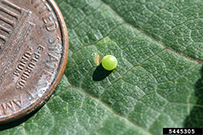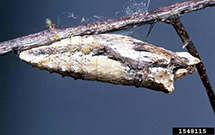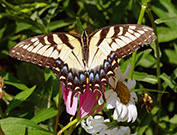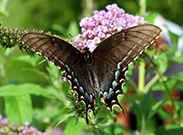home | spring garden | newcomer school garden
Eastern Tiger Swallowtail
Throughout its lifecycle from eggs to adults, eastern tiger swallowtails are camouflaged in order to trick predators. Their tiny green spherical eggs easily blend in to leaf surfaces. When the eggs hatch, the new caterpillars are brown with some white markings, resembling bird droppings. As they molt and mature, caterpillars turn green and develop two large spots on both sides of their body near their head. To predators, these spots look like the eyes of a larger animal such as a snake, so predators might be discouraged from attacking the caterpillar. When the caterpillar pupates, it creates a chrysalis that blends in with tree bark. Wings of adult females have larger black lines and spots than wings of males. Females can be one of two forms, yellow or dark. Adult butterflies visit plants such as butterfly bush, oregano, zinnia, purple coneflower, and phlox, or overripe fruit.

|

|

|

|

|
